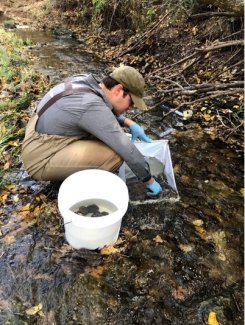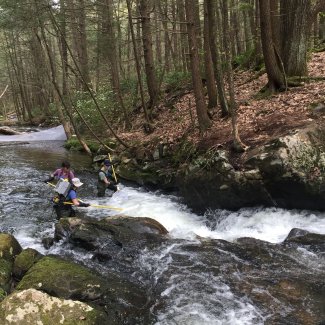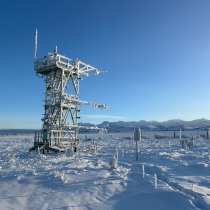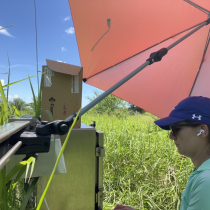Domain Digest No. 6: Community Connections
August 24, 2022
Community Engagement and STEM Education are at the heart of our mission at the NEON program. Engaging with the scientific community and with local universities and community groups helps us build our community of data users, create a career pipeline, and make our resources better. This summer, many of our Domains hosted tours and events to give visiting researchers and students a glimpse into our work.
RCN Workshop at NIWOT Ridge – Domains 10/13 (Colorado)
In June, organismal biologists from across North America congregated at the Niwot Ridge Mountain Research Station in Colorado, home of our NIWO terrestrial field site in D13. The four-day workshop, held June 12-15, was organized by the NSF Research Coordination Network (RCN) as part of a five-year NSF grant focused on using NEON data to answer key questions in organismal biology. Dr. Ben Dantzer, an associate professor at the University of Michigan, spearheaded the event.
The workshop drew about 25 participants, including biologists, zoologists, mammalogists, botanists, and limnologists representing universities across the U.S. and Canada. It was the first meeting of the new RCN for organismal biology; additional meetings will be planned over the next four summers to continue the conversation. This year's focus was "Using Network Theory to Identify How Individuals, Populations, Communities, and Ecosystems Respond to Environmental Change." NEON staff from Science Team and D10/13 Field Science Team participated in breakout groups and led sessions introducing attendees to NEON data products, sampling design, and sampling protocols.
Kelley McCahill, a field ecologist and mammalogist for D10/D13, provided an overview of the NEON program for the group. "The goal of the workshop was to get more organismal researchers involved with the NEON program and introduce them to all of the observations and samples that we collect for aquatics, flora, and fauna at the NEON field sites," she says. "Many of them were unaware of the rich data available for organismal research from NEON. They were very excited to see what was available and learn about our sampling protocols." Many of the researchers also shared their plans for using NEON data with their students and in their own research. Future meetings will be planned in other Domains and will include tours of the field sites and sample plots.
Texas A&M Students Tour Pringle Creek – Domain 11 (Texas)
Students from Texas A&M University got an up-close look at field science in action at the Pringle Creek (PRIN) aquatic field site in May. The event was requested by Dr. Gabriela Sosa, a research assistant professor for Environmental Policy at Texas A&M, as part of an NSF BREDEI (Broadening Research Experience for Increasing Diversity, Equity and Inclusion) grant focused on Improving Undergraduate STEM Education for Hispanic-Serving Institutions (HSI). Seven undergraduate students, two graduate students, and their professors and coordinator spent three days at PRIN getting familiar with aquatic sampling protocols and instruments.
Kaitlan Jones, a technician specialist on the Aquatics team for D11, demonstrated sampling protocols, including discharge, surface water chemistry, dissolved gases, and aquatic plant and macroinvertebrate collection. Cody Watson, a technician on the Instrument Systems team, showed them the on-site instruments and provided an overview of aquatic instrument data. On the third day, Marie Faust, science outreach specialist, led a data workshop.

Collecting macroinvertebrates using a Surber sampler at the Domain 11 PRIN field site (Photo by Kaitlan Jones).
Jones reports that it was a positive and eye-opening experience for participating students. "Many of them had not had the opportunity to do field work before. It was great for them to be able to see, if you want to be a field ecologist, this is what your day-to-day work is going to look like. Fieldwork isn't always what you expect, so it's really valuable for them to be able to see this at this stage of their careers. They asked a lot of pointed questions and were really interested in our career paths and how we came to work at NEON."
The students will be using NEON aquatic data in their own research over the next semester. They will be back next winter to present their projects to the NEON team. Jones says, "It's really important for us at NEON to connect with the local scientific communities who are using our data and develop ties with local universities. These are the ones who will use our data throughout their careers, and the students we want to hire when they graduate. This was a great way to get more exposure for NEON and provide networking opportunities for students, especially those who haven't had prior opportunities to participate in this kind of work."
Notre Dame Students Join AOP Tours – Domain 05 (Wisconsin)
Ever wonder what the inside of one of the Airborne Observation Platform (AOP) planes looks like? NEON Field Science staff from Domain 05 (Great Lakes) had the opportunity to check out the plane and its instrumentation during two tour dates in June, along with some visiting field staff from Domain 09 (Northern Plains). During the second tour, they also welcomed some guests from the University of Notre Dame and the University of Wisconsin – Madison.
D05 Headquarters is located at the University of Notre Dame's Environmental Research Center in Land O' Lakes, WI. Every summer, UNDERC offers education and research programs for approximately 25 to 35 undergraduate and graduate students. Several of these students were able to attend the June 28 tour. This year, some of the UNDERC students were doing a field project that utilized AOP data, so they had an opportunity to learn more about how the data are collected.
D05 also welcomed Kyle Kovach, a researcher from the University of Wisconsin – Madison, who was in the area collecting leaves in the Chequamegon Nicolet National Forest. Because Kyle's research utilizes AOP data, Peter Weishampel, the field science manager for D05, thought he might be interested in the tour as well. Kovach and three others, all researchers and students in Dr. Phil Townsend's lab, were able to attend the second tour.
During the tours, AOP staff showed off the Twin Otter aircraft and instrumentation and described their work for the NEON program. The AOP aircraft are equipped with a sophisticated array of payload sensors, including discrete and full-waveform lidar, an imaging spectrometer, and a high-resolution digital camera, along with a GPS antenna and Inertial Measurement Unit for high-accuracy positioning. These tours provide a great opportunity for both NEON Domain staff and NEON data users to get an inside look into how remote sensing data are collected.
Middlebury College Students at Lower Hop Brook – D01 (Massachusetts)
At Lower Hop Book (HOPB) in D01, Field Operations Manager Kristen Godfrey and Aquatic Ecologist Ryan Williams hosted Dr. Eric Moody, an assistant professor of Biology at Middlebury College in Virginia, and several students from his lab. Moody is the co-PI on a NEON Assignable Asset project.
Moody and his co-PI are gathering additional benthic invertebrate samples from all of the NEON aquatic sites for stable isotope and elemental analysis. This summer, his lab had a large number of undergraduate students involved in gathering these samples. Because HOPB is within driving distance of Middlebury College, he reached out to Godfrey to see if he could set up a tour. The D01 staff welcomed Moody and nine of his students on June 22.

Fish sampling at Lower Hop Brook (HOPB) NEON aquatic site.
Participants were given a general tour of the HOPB field site. They also watched and participated in a demonstration of NEON's aquatic invertebrate collection methods, led by Williams. The event gave students a better idea of the context in which NEON aquatic samples are collected as well as a greater understanding of the NEON program as a whole.
D01 has conducted similar 'field demos' this year at Harvard Forest (HARV) for students participating in the Research Experiences for Undergraduates (REU) program. Students at HARV were working with NEON beetle data through an Assignable Asset request.



